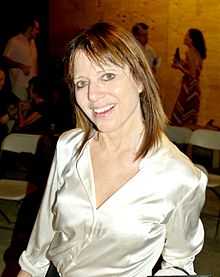Judy Rifka
| Judy Rifka | |
|---|---|
 Rifka at the 2010 launch of John Reed's Tales of Woe | |
| Born |
September 25, 1945 New York City |
| Nationality | American |
| Education | New York Studio School |
| Known for | Painting |
Judy Rifka (born 1945) is an American artist active since the 1970s[1] as a painter and video artist. She works heavily in New York City's Tribeca and Lower East Side and has associated with movements coming out of the area in the 1970s and 1980s such as Colab [2][3][4][5][6] and Fluxus.[7][8]
Art and Context
Rifka took part in the 1980 Times Square Show, two Whitney Museum Biennials (1975, 1983), Documenta 7, Just Another Asshole (1981), curated by Carlo McCormick and received the cover of Art in America in 1984 for her series, "Architecture," which employed the three-dimensional stretchers that she adopted in exhibitions dating to 1982; in a 1985 review in the New York Times, Vivien Raynor noted Rifka's shift to large paintings of the female nude, which also employed the three-dimensional stretchers.[9] In a 1985 episode of Miami Vice, Bianca Jagger played a character attacked in front of Rifka's three-dimensional nude still-life, "Bacchanaal", which was on display at the Museum of Art Fort Lauderdale.
Rene Ricard said of Rifka in his influential December 1987 Art Forum article about the iconic identity of artists from Van Gogh to Jean-Michel Basquiat and Keith Haring,The Radiant Child,[10] "We are that radiant child and have spent our lives defending that little baby, constructing an adult around it to protect it from the unlisted signals of forces we have no control over. We are that little baby, the radiant child, and our name, what we are to become, is outside us and we must become “Judy Rifka” or “Jean-Michel” the way I became “Rene Ricard.”
Judy Rifka's pop figuration is noted for its nervous line and frenetic pace. Joseph Masheck described Rifka in his 1993 book, Modernities (see excerpt below).
- “Rifka’s wit, which luckily keeps up with her anxious agitation, entails putting high care into a ‘careless’ look. And in a world charged with contending impersonal forces, this is like advertising in reverse, ‘pushing’ the individual consciousness in all its brave fragility.”
In the January 1998 issue of Art in America, Vincent Carducci echoed Masheck, “Rifka reworks the neo-classical and the pop, setting all sources in quotation for today’s art-world cognoscenti.” [11] Rifka, along with artists like David Wojnarowicz, helped to take Pop sensibility into a milieu that incorporated politics and high art into Postmodernism; Robert Pincus-Witten stated in his 1988 essay, Corinthian Crackerjacks & Passing Go:
- “Rifka’s commitment to process and discovery, doctrine with Abstract Expressionist practice, is of paramount concern though there is nothing dogmatic or pious about Rifka’s use of method. Playful rapidity and delight in discovery is everywhere evident in her painting.”
References
- ↑ , New York Times, Sunday, February 3, 1974
- ↑ , New York Times Frank Emblen, Sunday, August 23, 1987
- ↑ , Gray Art Gallery at NYU, "Sublime Time"
- ↑ , New York Times, Michael Brenson, January 25, 1985
- ↑ David Little, Colab Takes a Piece, History Takes It Back: Collectivity and New York Alternative Spaces, Art Journal Vol.66, No. 1, Spring 2007, College Art Association, New York, pp. 60-74
- ↑ Carlo McCormick, The Downtown Book: The New York Art Scene, 1974–1984, Princeton University Press, 2006
- ↑ Huffington Post, James Scarborough. Facebook as an Artistic Platform: An Interview With Judy Rifka. http://www.huffingtonpost.com/james-scarborough/facebook-as-an-artistic-p_b_3361555.html
- ↑ Charlie Finch.Collectivism Works! - artnet Magazine http://www.artnet.com/magazineus/features/finch/finch1-22-09.asp
- ↑ , New York Times Vivien Raynor, Friday, October 18, 1985
- ↑ Ricard, Rene. "The Radiant Child". Art Forum. Retrieved 19 January 2015.
- ↑ , Art in America, Vincent Carducci, January, 1998
External links
|